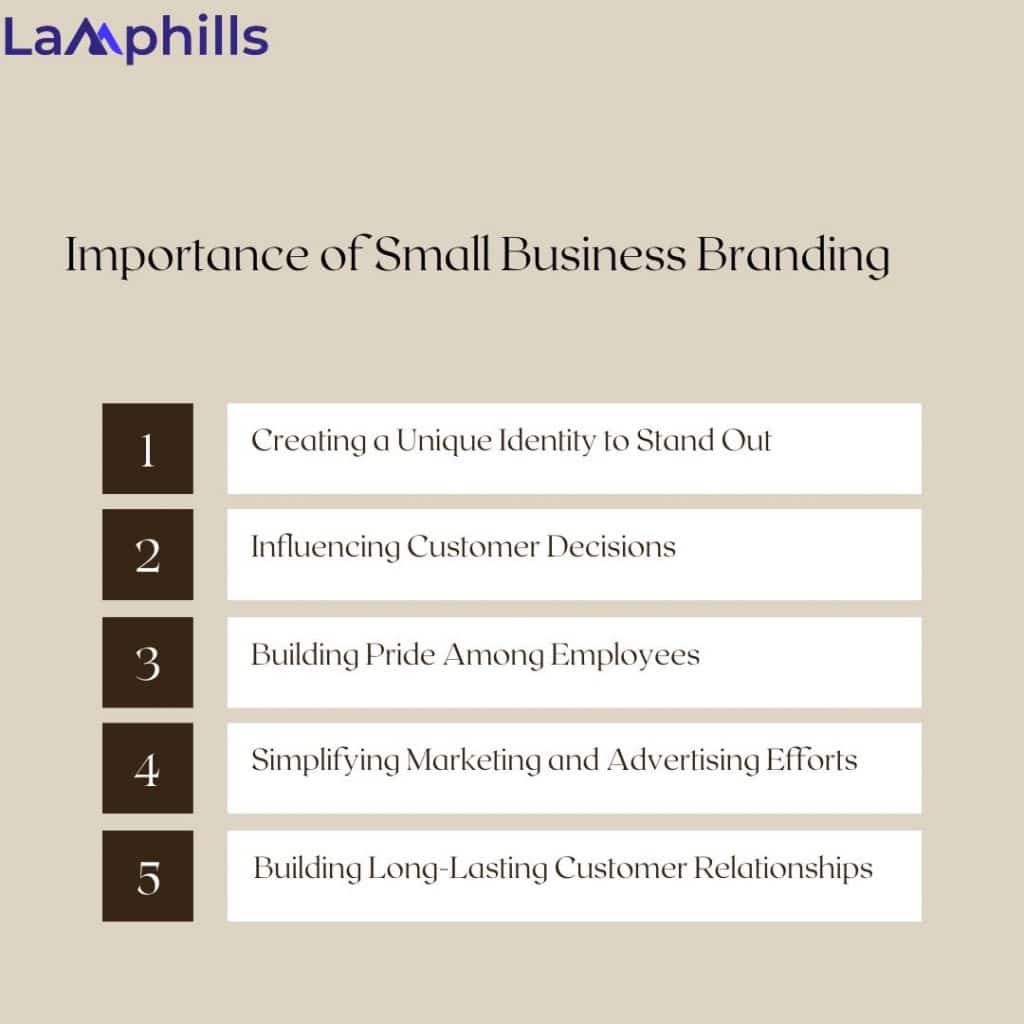Have you ever wondered what sets successful small businesses apart in a crowded market? Small company branding goes beyond just having a catchy logo or a memorable tagline; it’s about creating a unique identity that connects emotionally with customers. For small business owners, understanding effective branding strategies can make all the difference in building a loyal customer base and establishing a credible presence in the industry.
In this article, I will list ten effective strategies and steps for successful small business branding. From defining your brand’s purpose to designing a cohesive visual identity, each tip is designed to help you connect with your audience meaningfully. I will also cover the importance of understanding your target market, maintaining a consistent brand voice, and adapting to customer needs—all essential elements that contribute to your branding success. Whether you’re just starting out or looking to refine your existing brand, these small business branding tips will guide you in crafting a memorable and impactful brand identity that stands the test of time.
Key Points
- It’s about building a recognizable and trustworthy identity that resonates with customers beyond just logos or slogans.
- Analyze demographics, psychographics, and behaviors to understand who your ideal customers are.
- Choose a simple, easy-to-remember name that reflects your business’s mission and values.
- Develop a coherent voice that reflects your brand’s personality across all communication platforms.
What Is Small Business Branding?
For small businesses, branding is about building an identity that customers can easily recognize, remember, and trust. Unlike large corporations, which may rely on broad, complex strategies, small business branding focuses on creating a personal and memorable connection. It’s not just about a logo or a catchy tagline; it’s about shaping how customers perceive and feel about your business.
Branding starts with defining what makes your business unique and valuable to your customers. This involves understanding your target audience, their needs, and how you want them to feel about your business.
For example, if you run a local bakery known for handmade treats, your brand might emphasize warmth, community, and quality. Every branding element, from your logo and color scheme to the friendly tone of your social media posts, should reflect this feeling.
Strategies for Establishing Your Small Business Brand Identity
Creating a standout brand identity is essential for any small company branding effort. To help you navigate this process, I’ve outlined 12 effective strategies that will not only clarify your brand but also ensure it connects with your target audience.
#1. Define Your Brand’s Purpose
Your brand’s purpose acts as its guiding star—a meaningful “why” that directs everything you do. It’s essential for giving your customers a compelling reason to support your business. Reflect on your origins and values to articulate this purpose. Ask yourself: Why did you start this business? What problems are you solving? What principles guide your actions today and in the future?
Craft a clear purpose statement that distills these insights into a compelling narrative. For instance, LEGO’s purpose, “to inspire and develop the builders of tomorrow,” is simple yet powerful. A tagline like this is memorable and can easily be displayed across various platforms.
#2. Identify Your Target Market
Understanding your target market is vital in the realm of small business branding tips. This is the group of people most likely to purchase your products or services. A clearly defined target market leads to better communication, improved product development, and higher customer satisfaction.
To identify your target market, analyze your product or service and consider factors such as demographics (age, income, location), firmographics (business type), psychographics (values and lifestyles), and behaviors (brand loyalty and usage).
This analysis will help you connect more effectively with your ideal customers. Remember, you may have multiple target customers; define each one and the best channels to reach them.
#3. Conduct a Competitive Analysis
A competitive analysis is crucial in establishing your small company branding. Identify local and online competitors that offer similar products or services. Understand both direct competitors (those selling the same products) and indirect competitors (those whose offerings can substitute for yours).
Gather data on their products, marketing strategies, and customer feedback. Analyze what customers appreciate about them and where they fall short. For example, if customers complain about slow service at a rival bakery, you can leverage this insight by highlighting your own quick service as a unique selling point.
#4. Develop a Memorable Brand Name
Your brand name is foundational to your small business branding. A memorable name not only sets you apart but also builds emotional connections with customers.
Focus on your mission and unique qualities when brainstorming names. Keep it simple and easy to remember. Test potential names with potential customers to gauge their reactions. This feedback can be invaluable, especially in ensuring the name doesn’t carry unintended meanings in different languages or cultures.
#5. Design a Compelling Logo
A logo is often the first impression of your company, making it a critical element of your small company branding. Aim for simplicity and versatility in your logo design—an uncomplicated design that works well across various applications. Your logo should connect with your audience and evoke the desired emotions.
For instance, the logo for Uncorked cleverly integrates a corkscrew shape while hinting at a Celtic knot, creating a visual that is both fun and meaningful.
#6. Maintain a Consistent Brand Voice
Your brand voice conveys your personality and emotions in all communications. It’s essential to have a coherent voice that resonates with your audience and reflects your brand’s mission.
Choose three adjectives that best describe your voice, and ensure consistency across all platforms. Whether your voice is friendly and approachable or confident and professional, clarity in communication helps strengthen customer connections.
#7. Design a Cohesive Visual Identity
Visual identity goes beyond the logo; it includes typography, color schemes, imagery, and layouts. Each element should evoke specific feelings associated with your brand. When selecting typography, consider your brand’s tone—modern fonts for a tech company versus playful fonts for a children’s store.
Color psychology also plays a crucial role; choose colors that resonate with your target audience. For example, a financial institution might opt for trustworthy blues, while a creative agency might prefer vibrant colors.
#8. Use Content to Build Brand Awareness and Loyalty
Content marketing is a powerful way to establish your brand’s authority and provide value to your audience. For small business branding, creating high-quality content that educates, entertains, or informs your audience can position your brand as a go-to resource.
For example, if you’re a skincare brand, share content on skincare routines, ingredient benefits, and seasonal skincare tips. By regularly sharing valuable content, you encourage your audience to keep returning, building loyalty over time. Blog posts, social media updates, videos, and newsletters are all effective ways to reach your audience and reinforce your brand values consistently.
#9. Adapt and Evolve with Your Customers
Branding isn’t a one-time effort—it’s an ongoing process. As your small business grows, your brand should adapt to changing market trends and customer expectations. Think about how brands like Netflix have evolved; starting as a DVD rental service, it adapted to streaming and has stayed relevant by listening to its customers’ preferences.
Regularly evaluate your branding and make adjustments as needed. Gather feedback from customers to understand how they view your brand and what improvements they’d like to see. This proactive approach keeps your brand fresh and aligned with your audience’s evolving needs.
#10. Showcase Social Proof and Customer Stories
When customers see others like themselves choosing your brand, it builds trust. Showcasing testimonials, reviews, and case studies on your website and social media can create a powerful brand reputation. Highlighting real customer stories adds authenticity and gives potential customers confidence that they’ll have a positive experience with your brand as well.
If you’re a small business offering specialized products or services, consider sharing stories of how your offerings have made a difference in customers’ lives. This can turn your customers into advocates who naturally promote your brand through word-of-mouth.
Importance of Small Business Branding

Building a strong brand is essential for any small company aiming to succeed in today’s competitive market. For a small business, branding isn’t just an asset; it’s the core of how you communicate your values, attract loyal customers, and establish credibility.
Let’s dive into why branding is so crucial for a small company and explore some practical branding tips to elevate your business:
#1. Creating a Unique Identity to Stand Out
In a crowded market, branding sets you apart by giving your business a distinct personality. Consider the example of choosing between a familiar brand, like Nike, and a generic alternative. Even if the unbranded product is cheaper, many consumers gravitate towards the known brand because it represents quality and reliability.
As a small company, branding allows you to create that unique appeal. By consistently using your brand’s message, visuals, and voice, you’re building a recognizable image that people trust.
#2. Influencing Customer Decisions
Branding can strongly influence customer purchasing decisions. Many consumers, especially younger ones, prefer brands that align with their values. Whether it’s eco-friendly practices, quality craftsmanship, or customer service, your brand can attract people who connect with what you stand for. For instance, a brand like Dove is more than just a beauty company—it’s become synonymous with positive body image.
Small businesses can use this approach to convey a purpose beyond profit, creating a brand that people feel good supporting.
#3. Building Pride Among Employees
A strong brand not only attracts customers but also builds pride and loyalty among employees. Think about big brands like Disney or Google; employees feel a sense of belonging and purpose working there, even in roles that aren’t high-profile. This sense of pride can be especially powerful for small businesses. By creating a positive brand that employees are proud of, you foster a community and a sense of ownership, motivating everyone to contribute to the brand’s success.
#4. Simplifying Marketing and Advertising Efforts
With strong branding, advertising becomes much easier. Once you’ve established a solid reputation, your marketing materials gain weight and relevance. Your brand’s colors, font, and tone of voice make your promotions more recognizable and impactful. For instance, Nike’s “Just Do It” slogan and swoosh logo have become iconic, instantly making any campaign feel powerful and cohesive.
#5. Building Long-Lasting Customer Relationships
Branding helps you create a community of loyal customers. Companies with strong brands often inspire a fan base that sticks with them through thick and thin. Small companies, too, can foster this loyalty by creating personal connections with customers.
By investing in a unique brand that represents your values, you can build trust that keeps people coming back, creating a reliable customer base even as your business grows.
#6. Establishing Credibility in the Market
Credibility is critical for small businesses, and branding helps you build it. Many top brands—like Apple, McDonald’s, and Google—have earned such strong credibility that their names are almost synonymous with their industries. For a small company, a trusted brand identity makes you appear more professional and reduces the perceived risk for potential customers, encouraging them to choose you over less recognizable options.
Small business branding tip: consistently deliver on your promises to build a strong reputation. This includes maintaining product quality, staying reliable, and supporting customers when they need it. The more you prove your brand’s reliability, the stronger your credibility becomes.
#7. Increasing Your Business’s Overall Worth
Strong branding can also boost the financial value of your business. This is true not just for large corporations but also for small businesses. For example, consumers are often willing to pay more for products from established brands because they trust the quality. Even if your prices are higher than a competitor’s, a strong brand can justify the cost by signaling reliability and value.
#8. Creating a Lasting Impact
A strong brand is one that evolves with time, staying relevant as trends and consumer needs change. Brands that adapt well can remain popular and influential for decades, while those that stay stagnant often fade. Think of Netflix, which transformed from a DVD rental service to a dominant streaming platform. This adaptability has allowed them to retain brand strength even as the industry changed drastically.
What Are the 5 Elements of Branding?
You might think that since you have a logo, tagline, and business card, you’ve completed your branding. But, unless you’ve carefully considered and defined ALL five of the key brand elements—position, promise, personality traits, story, and associations—you still have work to do.
What Is an Example of Branding in Business?
From the coffee cup we’re handed at Starbucks to the toothpaste we choose from the shelves of grocery stores and the ads we see on our smartphones. Companies like Coca-Cola, Apple, and Starbucks have product branding that is so recognizable we take it as a normal part of our environment.
How to Start Branding Your Small Business?
How to build a brand in 7 steps:
- Research your target market.
- Determine your brand’s voice and personality.
- Choose your business name.
- Write your brand story.
- Create a brand-style guide.
- Design your logo and brand assets.
- Apply your branding across your business.
Conclusion
Branding is more than just a logo or a catchy name; it’s about creating a lasting impression that resonates with your audience. By defining your mission, vision, and values, choosing an impactful name, developing a strong visual identity, establishing a consistent brand voice, and staying relevant, you can build a powerful brand that stands out in today’s competitive market.
Implementing these small business branding tips can significantly influence your success, helping you connect with your audience and establish a brand that they trust and remember.
Remember, effective branding is an ongoing journey, so stay flexible and be ready to adapt as your business grows.
Related Articles
- How a Video Film Company Transforms Your Vision into Reality: Examples and How To Choose
- The Ultimate Guide to Choosing the Right Startup Branding Agency
- Top 10 Branding Agency Services in Nigeria in 2024
- Complete Branding Package for Small Businesses: Examples, What to Include and Best Practices






